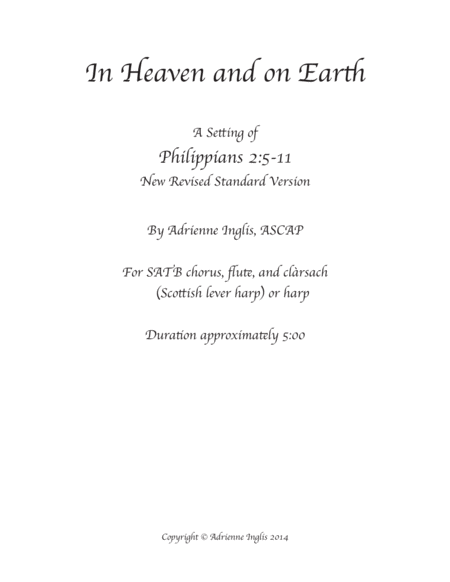Choral Choir (SATB) - Level 3 - Digital Download SKU: A0.953621 Composed by Adrienne Inglis (ASCAP). Celtic,Christian,Contemporary,Sacred. Octavo. 19 pages. Adrienne Inglis (ASCAP) #4807817. Published by Adrienne Inglis (ASCAP) (A0.953621). One of the most powerful passages in scripture set to music! Good length for an anthem, interesting and idiomatic use of flute and harp, nice mix of beautiful melodic passages and crunchy bits!A Setting of Philippians 2:5-11 from New Revised Standard VersionFor SATB chorus, flute, and clà rsach (Scottish lever harp) or harp or pianoDuration approximately 5:00 The Letter of Paul to the Philippians 2:5-11 (NRSV)*Let the same mind be in you that was in Christ Jesus, who, though he was in the form of God, did not regard equality with God as something to be exploited, but emptied himself, taking the form of a slave, being born in human likeness. And being found in human form, he humbled himself and became obedient to the point of death - even death on a cross.Therefore God also highly exalted him and gave him the name that is above every name, so that at the name of Jesus every knee should bend, in heaven and on earth and under the earth, and every tongue should confess that Jesus Christ is Lord, to the glory of God the Father. *New Revised Standard Version Bible, copyright © 1989 National Council of the Churches of Christ in the United States of America. Used by permission. All rights reserved.Composed by Adrienne Inglis in 2014 and premiered in 2014 in Austin, Texas, by the Westminster Presbyterian Church Sanctuary Choir, In Heaven and on Earth for SATB chorus, flute, and clà rsach, draws inspiration from the tune Love is the Cause of my Mourning from The Caledonian Pocket Companion Book 1, p. 27. The piece opens with the tune altered to G mixolydian mode. As the word exploited appears, a sinister-sounding E flat enters the harmony. Open octaves between soprano and bass show the emptying, followed by a shift to E phrygian mode with the word slave. Several dissonances emerge as the narrative gets darker. The flute and clà rsach represent chaos or hell with an aleatoric interlude of extended techniques involving tongue rams, flutter tonguing, multiphonics, spoken syllables, and lever glissandi. The harp then joyfully proclaims the new tonality of G major in a fanfare to introduce the text of praise and exaltation. The original source tune returns harmonically restored to G major.
